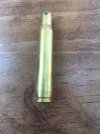Note that both pix showing incipient case head separation were of belted cases. They are typically more at risk of case head separation because they headspace on the belt, so the case can stretch from that point forward (i.e., toward the neck.).
What you have described sounds like typical Garand stretching. You will probably find it harder to resize, and you will be working the brass more so it will probably wear out sooner, but you should be able to reload it safely several times.
The most misunderstood piece of information about belted cases.
No matter what type of case is getting head separations, there is only ONE cause.
EXCESSIVE HEADSPACE.
There are 2 ways for this to happen. A chamber problem, which would show up the first time the rifle was fired.
The other is RELOADER INDUCED EXCESSIVE HEADSPACE.
A belted case DOES NOT stretch at the web to fill the chamber as you have described causing incipient head separation. The belt holds the case in place, pressure forces the case out in ALL DIRECTIONS and the thinner part of the case expands to fill the chamber FIRST.
This is the neck, shoulder and upper body.
They then GRIP the chamber and any STRETCHING is halted because the case was already being held by the belt.
The ONLY way to get head separation in a belted case is by pushing the SHOULDER back too far on each subsequent sizing….it's that simple.
It has been noted that certain chamber designs that do not support the head sufficiently allow the case to stretch above the web, but they are rare these days.
I really wish people would stop bashing belted cases because they read something and it simply isn't correct what they read.
Gun writers have spouted so much crap over the years with unfounded BS, it's not funny. Just like a belt isn't conducive to accuracy…..really! Why is a 300WM so accurate then?
Cheers.

